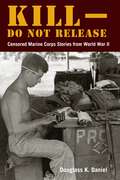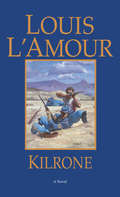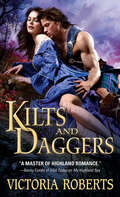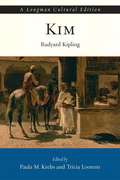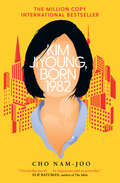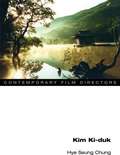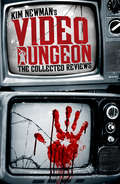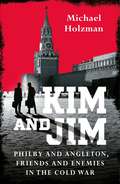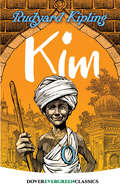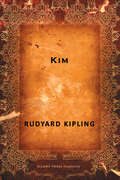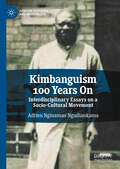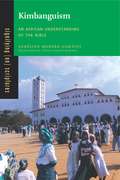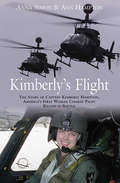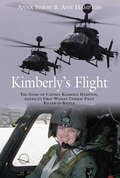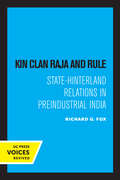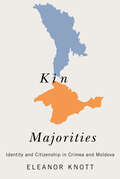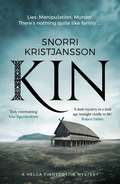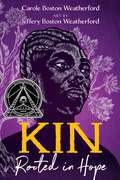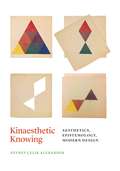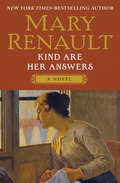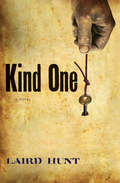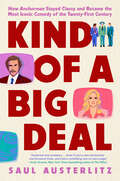- Table View
- List View
Kill–Do Not Release: Censored Marine Corps Stories from World War II (World War II: The Global, Human, and Ethical Dimension)
by Douglass K. Daniel“Fighter-Writer” reports from major battles in the Pacific highlight what America’s Marines endured in World War IIDouglass K. Daniel presents a fascinating trove of previously classified material withheld from the public because of government and public relations concerns at the time, including tactical details that could inadvertently aid the enemy, battlefield gore that could disturb readers, and the gamut of issues of taste. Navy censors in the field and editors at Marine Corps headquarters in Washington were also on alert for any material that could negatively affect the Corps itself or the overall war effort. Soul-searching stories that questioned the nature of war were rejected lest they sow doubt stateside about the cause for which so many lives were being lost.Behind the bylines was a new breed of storytellers. Considered “fighter-writers,” Marine combat correspondents, or CCs, carried typewriters as well as weapons. The Marine Corps Division of Public Relations recruited them from America’s newsrooms to join the fight that stretched from Guadalcanal and the bloody assault on Tarawa to the black sands of Iwo Jima and the dense jungles of Okinawa. Their approved work appeared in civilian newspapers, magazines, and other national and local media.This collection also highlights the unique efforts of the CCs and the public relations officers who commanded them. While they were assigned to report and write, they were Marines first. They eagerly put aside their notebooks to take up arms against the enemy as needed. Many were wounded in battle, and more than a dozen were killed, giving their lives to get the story behind the most significant conflict in human history.
Kilrone
by Louis L'AmourWhen Major Frank Paddock and Barnes Kilrone were dashing young officers in Paris, they both fell in love with the same woman. But now they are men in exile in one of the harshest territories of the American West. It is against this inhospitable backdrop, where survival itself is a day-to-day struggle, that Paddock makes a fateful decision that will plunge both men into a headlong battle for their lives and the lives they're sworn to protect. As Paddock leads his company of soldiers in pursuit of a Bannock war party, Kilrone is left behind to guard the post's women and children. And before the day is over, one of them, outnumbered and outgunned, will be trapped in a fight to the finish....
Kilts and Daggers
by Victoria Roberts"This book begs to be read and reread."-RT Book Reviews, 4 1/2 stars on My Highland SpyEver since Lady Grace Walsingham discovered her uncle and sister are spies for the Crown, she has yearned for adventure. She's counting the days until she can leave barbaric Scotland behind, even if she must endure Highland captain Fagan Murray's company for weeks. Fagan has a simple mission: escort the haughty Lady Grace back to England. But nothing is ever easy. The sharp-tongued woman needles him at every turn. But when a menacing threat follows them on their journey, Fagan's grudging tolerance for Grace turns to respect...and into a perilous attraction that could seal their fate. More praise for My Highland Spy: "Beautiful! This book has it all."-Night Owl Reviews, 4.5 Stars, Reviewer Top Pick "One of the best... an outstanding Scottish romance."-Romance Reviews, 5 Stars"An exciting Highland tale of intrigue, betrayal, and love with a braw Highland hero and strong English heroine any reader will love."-Hannah Howell, New York Times bestselling author of Highland MasterHighland Spies series: My Highland Spy Kilts and DaggersPlaids and Petticoats
Kim
by Rudyard KiplingThe story unfolds against the backdrop of The Great Game, the political conflict between Russia and Britain in Central Asia. The novel made the term "Great Game" popular and introduced the theme of great power rivalry and intrigue.
Kim Jiyoung, Born 1982
by Cho Nam-JooThe runaway bestseller that has sold over one million copies internationally, Kim Jiyoung, Born 1982 is the most important book to have come out of South Korea since Han Kang’s The Vegetarian.Kim Jiyoung is the most common name for Korean women born in the 1980s.Kim Jiyoung is representative of her generation:At home, she is an unfavoured sister to her princeling little brother.In primary school, she is a girl who has to line up behind the boys at lunchtime.In high school, she is a daughter whose father blames her for being harassed late at night.In university, she is a good student who doesn’t get put forward for internships by her professor.In the office, she is an exemplary employee who is overlooked for promotion by her manager.At home, she is a wife who has given up her career to take care of her husband and her baby.Kim Jiyoung is depressed.Kim Jiyoung has started to act out.Kim Jiyoung is her own woman.Kim Jiyoung is insane. Kim Jiyoung’s husband sends her to see a psychiatrist.This is his clinical assessment of the everywoman in contemporary Korea.
Kim Ki-duk (Contemporary Film Directors)
by Hye Seung ChungThis study investigates the controversial motion pictures written and directed by the independent filmmaker Kim Ki-duk, one of the most acclaimed Korean auteurs in the English-speaking world. Propelled by underdog protagonists who can only communicate through shared corporeal pain and extreme violence, Kim's graphic films have been classified by Western audiences as belonging to sensationalist East Asian "extreme" cinema, and Kim has been labeled a "psychopath" and "misogynist" in South Korea. Drawing upon both Korean-language and English-language sources, Hye Seung Chung challenges these misunderstandings, recuperating Kim's oeuvre as a therapeutic, yet brutal cinema of Nietzschean ressentiment (political anger and resentment deriving from subordination and oppression). Chung argues that the power of Kim's cinema lies precisely in its ability to capture, channel, and convey the raw emotions of protagonists who live on the bottom rungs of Korean society. She provides historical and postcolonial readings of victimization and violence in Kim's cinema, which tackles such socially relevant topics as national division in Wild Animals and The Coast Guard and U.S. military occupation in Address Unknown. She also explores the religious and spiritual themes in Kim's most recent works, which suggest possibilities of reconciliation and transcendence.
Kim Newman's Video Dungeon
by Kim NewmanRipped from the pages of Empire magazine, the first collection of film critic, film historian and novelist Kim Newman’s reviews of the best and worst B movies. Some of the cheapest, trashiest, goriest and, occasionally, unexpectedly good films from the past 25 years are here, torn apart and stitched back together again in Kim’s unique style. Everything you want to know about DTV hell is here. Enter if you dare.
Kim and Jim: Philby And Angleton, Friends And Enemies In The Cold War
by Michael HolzmanKim Philby’s life and career has inspired an entire literary genre: the spy novel of betrayal. He was one of the leaders of the British counter-intelligence efforts, first against the Nazis, then against the Soviet Union. He was also the KGB’s most valuable double-agent, so highly regarded that today his image is on the postage stamps of the Russian Federation.
Kim: Aston And James Collection (Dover Children's Evergreen Classics)
by Rudyard KiplingThe son of an Irish soldier, Kim doesn’t really fit in with the other residents of his native Lahore or among India's British transplants. The 13-year-old orphan struggles to find an identity for himself, while living hand-to-mouth in the streets. When he's befriended by a Tibetan monk, Kim becomes the elderly lama's disciple and joins the quest to locate the sacred River of the Arrow. But Kim's adventures are only just beginning. Along the way, he's recruited to carry a secret message for British Intelligence, becoming an agent in "the Great Game" — the 19th-century contest between Russia and the British Empire for control over Central Asia. Kim's torn between the excitement of spying and the freedom of life on the road, and he faces a staggering challenge when his two worlds collide. Nobel Prize-winner Rudyard Kipling's vivid portrait of India during the 1890s recaptures the region's diversity of peoples and cultures in a tale that brims with intrigue and treachery.
Kim: Rudyard Kipling (Reading & Training Ser.)
by Rudyard KiplingThe orphaned son of impoverished Irish parents, Kimball O'Hara is making his living on the streets of British-occupied India when he befriends a lama who is undertaking a pilgrimage to find the River of the Arrow.When Kim's British parentage is discovered, he is taken from the lama's custody and sent to school in England, where is trained as a spy before being returned to India. Undertaking one last trip with the lama, with whom he has remained close, Kim must choose between a life of subterfuge and one of enlightenment.Be it mystery, romance, drama, comedy, politics, or history, great literature stands the test of time. ClassicJoe proudly brings literary classics to today's digital readers, connecting those who love to read with authors whose work continues to get people talking. Look for other fiction and non-fiction classics from ClassicJoe.
Kimbanguism 100 Years On: Interdisciplinary Essays on a Socio-Cultural Movement (African Histories and Modernities)
by Adrien Nginamau NgudiankamaFrom its genesis in 1921, Kimbanguism has constituted one of the most fascinating socio-cultural movements of the Kongo region. This interdisciplinary collection covers the socio-cultural dynamics of the Kimbanguist church and its contribution to African studies over the past hundred years. Scholars renowned for their Kongo studies work, such as Wyatt MacGaffey, John M. Janzen, and John K. Thornton, contributed to this collection.
Kimbanguism: An African Understanding of the Bible (Signifying (on) Scriptures #5)
by Aurélien Mokoko Gampiot Cécile Coquet-MokokoIn this volume, Aurélien Mokoko Gampiot, a sociologist and son of a Kimbanguist pastor, provides a fresh and insightful perspective on African Kimbanguism and its traditions.The largest of the African-initiated churches, Kimbanguism claims seventeen million followers worldwide. Like other such churches, it originated out of black African resistance to colonization in the early twentieth century and advocates reconstructing blackness by appropriating the parameters of Christian identity. Mokoko Gampiot provides a contextual history of the religion’s origins and development, compares Kimbanguism with other African-initiated churches and with earlier movements of political and spiritual liberation, and explores the implicit and explicit racial dynamics of Christian identity that inform church leaders and lay practitioners. He explains how Kimbanguists understand their own blackness as both a curse and a mission and how that underlying belief continuously spurs them to reinterpret the Bible through their own prisms. Drawing from an unprecedented investigation into Kimbanguism’s massive body of oral traditions—recorded sermons, participant observations of church services and healing sessions, and translations of hymns—and informed throughout by Mokoko Gampiot’s intimate knowledge of the customs and language of Kimbanguism, this is an unparalleled theological and sociological analysis of a unique African Christian movement.
Kimberley, ciudad diamante
by Carolina P. AlcaideEl apasionante romance de Claudia y Xander, que se debate entre el amor, el deber y el poder destructor de los celos. En los últimos años del siglo XIX, Claudia, una joven niñera, se traslada a la remota ciudad minera de Kimberley, en el interior de Sudáfrica, justo cuando empiezan a oírse tambores de guerra entre británicos y boers, granjeros descendientes de holandeses. El amor que siente hacia Xander, un apuesto oficial de los Ingenieros Reales, parece imposible de alcanzar. No solo les separa su nivel social, Claudia y Xander pertenecen a dos pueblos enemigos a punto de enfrentarse, sin embargo, la pasión nacerá en medio de la tempestad. Durante el largo asedio de la «Ciudad Diamante» su amor deberá sobrevivir al horror de la guerra y también al tormento de los celos, más devastador que las bombas. En esta historia, fiel a los hechos reales, los fantasmas de un pasado oscuro que reaparece y un presente marcado por la violencia tratarán de destruir un porvenir lleno de esperanza.
Kimberly's Flight
by Ann Hampton Anna SimonUS Army Captain Kimberly N. Hampton was living her dream: flying armed helicopters in combat and commanding D Troop, 1st Squadron, 17th Cavalry, the armed reconnaissance aviation squadron of the 82nd Airborne Division. An all-American girl from a small Southern mill town, Hampton was a top scholar, student body president, ROTC battalion commander, and highly ranked college tennis player. In 1998, she was commissioned as a second lieutenant in the army. Driven by determination and ambition, Hampton rapidly rose through the ranks in the almost all-male bastion of military aviation to command a combat aviation troop. On January 2, 2004, Captain Hampton was flying an OH-58D Kiowa Warrior helicopter above Fallujah, Iraq, in support of a raid on an illicit weapons marketplace, searching for an elusive sniper on the rooftops below. A little past noon, her helicopter was wracked by an explosion. A heat-seeking surface-to-air missile had knocked off the helicopter's tail boom. The helicopter crashed, killing Hampton. Kimberly's Flight is the story of Captain Hampton's exemplary life. This story is told through nearly fifty interviews and her own e-mails to family and friends, and is entwined with her mother's narrative of loving and losing a child.
Kimberly's Flight: The Story of Captain Kimberly Hampton, America's First Woman Combat Pilot Killed in Battle
by Ann Hampton Anna Simon“The story of an outstanding young woman who realized her ambition to rise in military, fly helicopters and lead soldiers into combat.” —Independent MailU.S. Army Captain Kimberly N. Hampton was living her dream: flying armed helicopters in combat and commanding D Troop, 1st Squadron, 17th Cavalry, the armed reconnaissance aviation squadron of the 82nd Airborne Division. An all-American girl from a small southern mill town, Kimberly was a top scholar, student body president, ROTC battalion commander, and highly ranked college tennis player. In 1998 she was commissioned as a second lieutenant in the Army. Then, driven by determination and ambition, Kimberly rapidly rose through the ranks in the almost all-male bastion of military aviation to command a combat aviation troop. On January 2, 2004, Captain Hampton was flying an OH-58D Kiowa Warrior helicopter above Fallujah, Iraq, in support of a raid on an illicit weapons marketplace, searching for an illusive sniper on the rooftops of the city. A little past noon her helicopter was wracked by an explosion. A heat-seeking surface-to-air missile had gone into the exhaust and knocked off the helicopter’s tail boom. The helicopter crashed, killing Kimberly. Kimberly’s Flight is the story of Captain Hampton’s exemplary life. This story is told through nearly fifty interviews and her own e-mails to family and friends, and is entwined with Ann Hampton’s narrative of loving and losing a child. “This inspiring story of self discipline, leadership, patriotism and sacrifice should be required reading for a country far removed from the concept of total war. Even the war’s staunchest critics will enjoy this unromanticized picture of heroism.” —On Point: The Journal of Army History
Kin Clan Raja and Rule: State-Hinterland Relations in Preindustrial India (Center for South and Southeast Asia Studies, UC Berkeley)
by Richard G. FoxThis title is part of UC Press's Voices Revived program, which commemorates University of California Press’s mission to seek out and cultivate the brightest minds and give them voice, reach, and impact. Drawing on a backlist dating to 1893, Voices Revived makes high-quality, peer-reviewed scholarship accessible once again using print-on-demand technology. This title was originally published in 1971.
Kin Majorities: Identity and Citizenship in Crimea and Moldova
by Eleanor KnottIn Moldova, the number of dual citizens has risen exponentially in the last decades. Before annexation, many saw Russia as granting citizenship to—or passportizing—large numbers in Crimea. Both are regions with kin majorities: local majorities claimed as co-ethnic by external states offering citizenship, among other benefits. As functioning citizens of the states in which they reside, kin majorities do not need to acquire citizenship from an external state. Yet many do so in high numbers.Kin Majorities explores why these communities engage with dual citizenship and how this intersects, or not, with identity. Analyzing data collected from ordinary people in Crimea and Moldova in 2012 and 2013, just before Russia’s annexation of Crimea, Eleanor Knott provides a crucial window into Russian identification in a time of calm. Perhaps surprisingly, the discourse and practice of Russian citizenship was largely absent in Crimea before annexation. Comparing the situation in Crimea with the strong presence of Romanian citizenship in Moldova, Knott explores two rarely researched cases from the ground up, shedding light on why Romanian citizenship was more prevalent and popular in Moldova than Russian citizenship in Crimea, and to what extent identity helps explain the difference.Kin Majorities offers a fresh and nuanced perspective on how citizenship interacts with cross-border and local identities, with crucial implications for the politics of geography, nation, and kin-states, as well as broader understandings of post-Soviet politics.
Kin: A dark, intense and compelling Viking mystery
by Snorri Kristjansson'For Vikings done right, come to Snorri Kristjansson' - Mark Lawrence'Truly entertaining' - Yrsa Sigurðardóttir'A dark mystery in a dark age brought vividly to life' - Robert FabbriEveryone loves a family reunion.970: For the first time since Helga was adopted, her family will be gathered in one place. But her siblings are coming with darkness in their hearts. Everyone knows their father, the Viking warlord Unnthor Reginsson, has a great chest of gold hidden somewhere on his land - and each of his heirs is determined to find it. Then one morning Helga is awakened by screams. Blood has been shed. Kin has been slain. All the clues point to one person - who cannot possibly be the murderer, at least in Helga's eyes. But if she's going to save an innocent from the axe, she's got to solve the mystery - fast . . .Lies. Manipulation. Murder. There's nothing quite like family . . .
Kin: A dark, intense and compelling Viking mystery (The Helga Finnsdottir Mysteries #1)
by Snorri Kristjansson'For Vikings done right, come to Snorri Kristjansson' - Mark Lawrence'Truly entertaining' - Yrsa Sigurðardóttir'A dark mystery in a dark age brought vividly to life' - Robert FabbriEveryone loves a family reunion. 970: For the first time since Helga was adopted, her family will be gathered in one place. But her siblings are coming with darkness in their hearts. Everyone knows their father, the Viking warlord Unnthor Reginsson, has a great chest of gold hidden somewhere on his land - and each of his heirs is determined to find it. Then one morning Helga is awakened by screams. Blood has been shed. Kin has been slain. All the clues point to one person - who cannot possibly be the murderer, at least in Helga's eyes. But if she's going to save an innocent from the axe, she's got to solve the mystery - fast . . . Lies. Manipulation. Murder. There's nothing quite like family . . .
Kin: How We Came to Know Our Microbe Relatives
by John L. IngrahamBy unlocking the evolutionary information contained in cells, biologists have been able to construct the Tree of Life and show that its three main stems are dominated by microbes. Plants and animals constitute a small upper branch in one stem. Soon we may know how life began over 3.5 billion years ago. John Ingraham tells this story of discovery.
Kin: Rooted in Hope
by Carole Boston WeatherfordA Coretta Scott King Honor Book An &“imaginative and moving&” (The Horn Book, starred review) portrait of a Black family tree shaped by enslavement and freedom, rendered in searing poems by acclaimed author Carole Boston Weatherford and stunning art by her son Jeffery Boston Weatherford.I call their names: Abram Alice Amey Arianna Antiqua I call their names: Isaac Jake James Jenny Jim Every last one, property of the Lloyds, the state&’s preeminent enslavers. Every last one, with a mind of their own and a story that ain&’t yet been told. Till now. Carole and Jeffery Boston Weatherford&’s ancestors are among the founders of Maryland. Their family history there extends more than three hundred years, but as with the genealogical searches of many African Americans with roots in slavery, their family tree can only be traced back five generations before going dark. And so from scraps of history, Carole and Jeffery have conjured the voices of their kin, creating an often painful but ultimately empowering story of who their people were in a breathtaking book that is at once deeply personal yet all too universal. Carole&’s poems capture voices ranging from her ancestors to Frederick Douglass to Harriet Tubman to the plantation house and land itself that connects them all, and Jeffery&’s evocative illustrations help carry the story from the first mention of a forebear listed as property in a 1781 ledger to he and his mother&’s homegoing trip to Africa in 2016. Shaped by loss, erasure, and ultimate reclamation, this is the story of not only Carole and Jeffery&’s family, but of countless other Black families in America.
Kinaesthetic Knowing: Aesthetics, Epistemology, Modern Design
by Zeynep Çelik AlexanderIs all knowledge the product of thought? Or can the physical interactions of the body with the world produce reliable knowledge? In late-nineteenth-century Europe, scientists, artists, and other intellectuals theorized the latter as a new way of knowing, which Zeynep Çelik Alexander here dubs “kinaesthetic knowing.” In this book, Alexander offers the first major intellectual history of kinaesthetic knowing and its influence on the formation of modern art and architecture and especially modern design education. Focusing in particular on Germany and tracing the story up to the start of World War II, Alexander reveals the tension between intellectual meditation and immediate experience to be at the heart of the modern discourse of aesthetics, playing a major part in the artistic and teaching practices of numerous key figures of the period, including Heinrich Wölfflin, Hermann Obrist, August Endell, László Moholy-Nagy, and many others. Ultimately, she shows, kinaesthetic knowing did not become the foundation of the human sciences, as some of its advocates had hoped, but it did lay the groundwork—at such institutions as the Bauhaus—for modern art and architecture in the twentieth century.
Kind Are Her Answers: A Novel (Vmc Ser. #67)
by Mary RenaultAn &“extraordinarily moving&” novel about a doctor trapped between his wife and his lover, by a New York Times–bestselling author (Boston Herald). Doctor Kit Anderson is starting to see his marriage in a new light. Relations are strained with Janet, his beautiful wife, who now strikes him as petty and narcissistic. With no shortage of work to busy him, Anderson resigns himself to the consolations of professional life—that is, until he meets Christie, the great-niece of a dying patient. Warm and vivacious, Christie stands in stark contrast to Kit&’s wife, and suggests hope of a second and more passionate act to his life. How long can their affair be kept secret, though, and does Kit want the best for Christie, or only for himself?
Kind One: A Novel
by Laird Hunt<P>As a teenage girl, Ginny marries Linus Lancaster, her mother's second cousin, and moves to his Kentucky pig farm "ninety miles from nowhere." <P>In the shadows of the lush Kentucky landscape, Ginny discovers the empty promises of Linus' "paradise"--a place where the charms of her husband fall away to reveal a troubled man and cruel slave owner. Ginny befriends the young slaves Cleome and Zinnia who work at the farm--until Linus' attentions turn to them, and she finds herself torn between her husband and only companions. <P>The events that follow Linus' death change all three women for life. Haunting, chilling, and suspenseful, Kind One is a powerful tale of redemption and human endurance in antebellum America. <P>Laird Hunt is the author of several works of fiction and a finalist for the 2010 PEN Center USA Award in Fiction. Currently on the faculty of the University of Denver's creative writing program, he and his wife, the poet Eleni Sikelianos, live in Boulder, Colorado, with their daughter, Eva Grace.
Kind of a Big Deal: How Anchorman Stayed Classy and Became the Most Iconic Comedy of the Twenty-First Century
by Saul AusterlitzFrom the author of Generation Friends, featuring brand-new interviews with Will Ferrell and Adam McKay, a surprising, incisive, and often hilarious book about the film that changed comedy, Anchorman. It&’s been nearly twenty years since Ron Burgundy burst into movie fans&’ lives, reminding San Diego to &“stay classy&” while lampooning a time gone by—although maybe not as far gone as we might think? In Kind of a Big Deal, comedy historian Saul Austerlitz tells the history of how Anchorman was developed, written, and cast, and how it launched the careers of future superstars like Will Ferrell, Steve Carell, and Paul Rudd, also setting the stage for a whole decade of comedy to come and influencing films like The 40-Year-Old Virgin, Talladega Nights, Knocked Up, Superbad, and so many more. But Kind of a Big Deal isn&’t only a celebration of Anchorman—it&’s also a cultural analysis of the film&’s significance as a sly commentary on feminism, the media, fragile masculinity, 1970s nostalgia, and more. Featuring brand-new interviews with stars such as Will Ferrell, director Adam McKay, and other key players, the book includes insider commentary alongside updated pop-culture analysis. And it also shares surprising stories and facts: from the film&’s original conception as a plane crash/cannibal comedy mashup to the surprising, real-life newscaster who inspired the character of Veronica. Overall, this is a celebration of a movie that millions love—but it&’s also an unsparing look back at what has and hasn&’t changed, since the 1970s and since 2004. Perfect for fans of the film and anyone who cares about comedy today, Kind of a Big Deal proves that the movie was, and is, exactly that.
